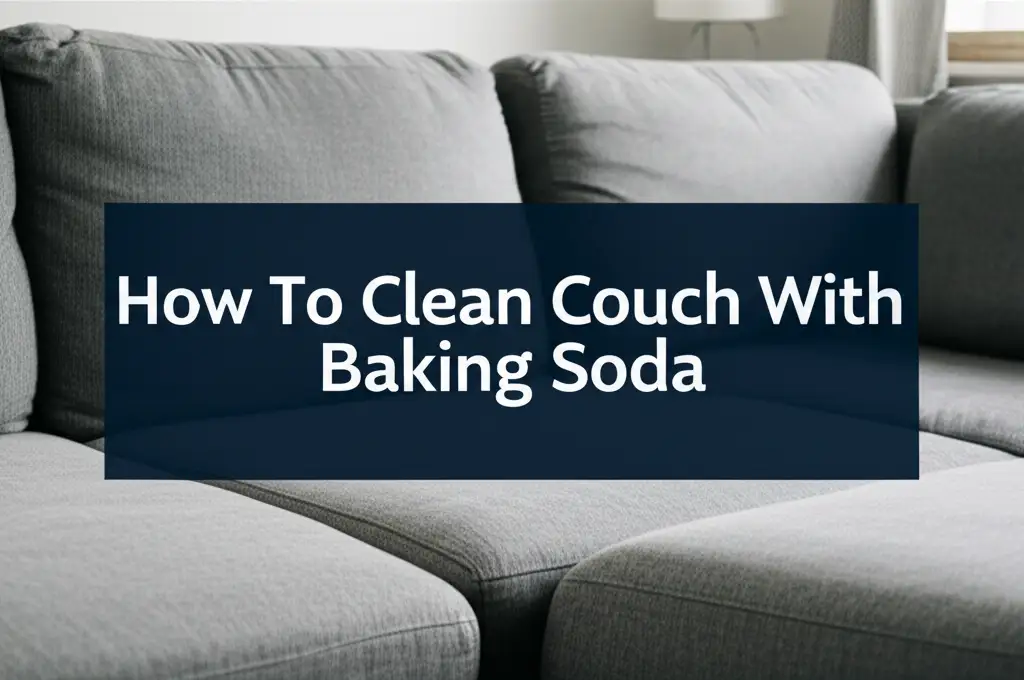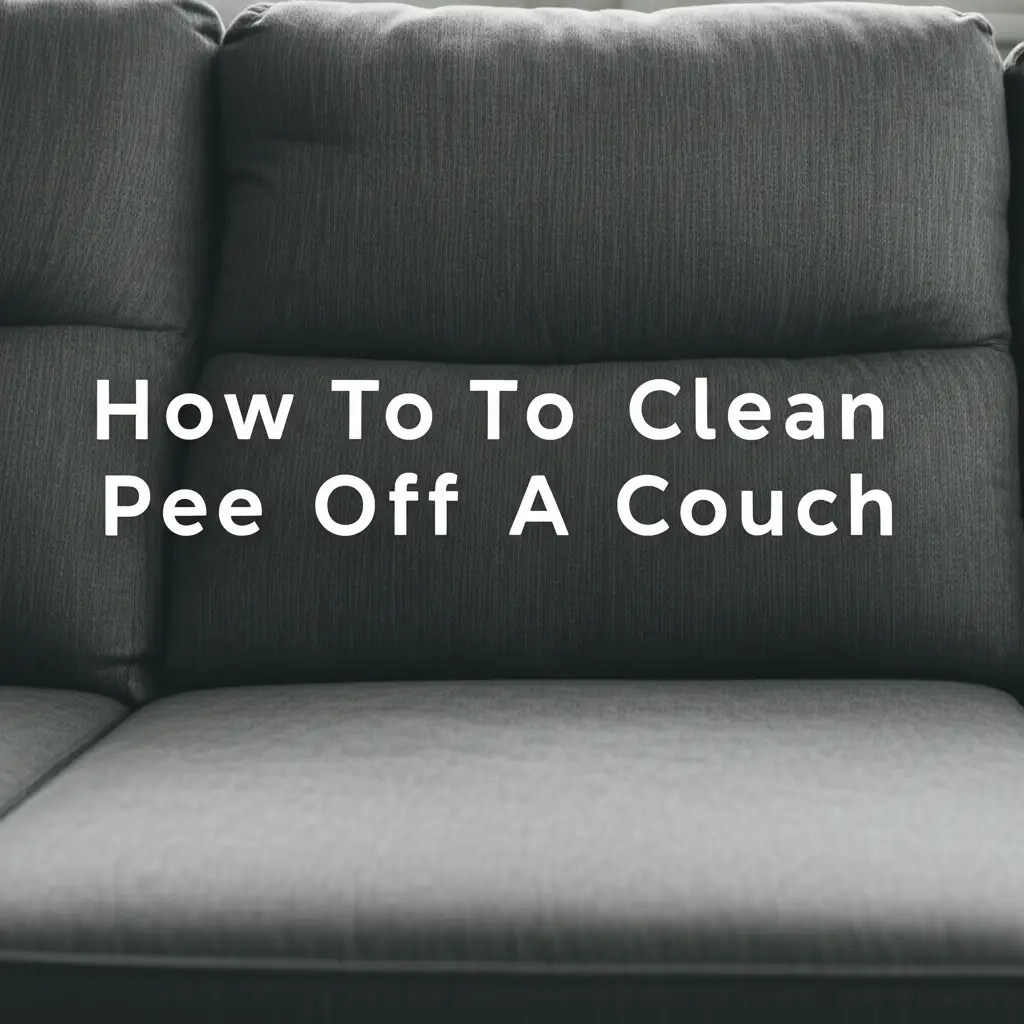· Home Cleaning · 14 min read
How To Clean Couch With Baking Soda

How To Clean Your Couch with Baking Soda for a Fresh Look
My couch is the heart of my living room. It handles movie nights, snack spills, and pet snuggles. Over time, it collects dust, absorbs odors, and can look a little dull. I used to dread the thought of deep cleaning it, imagining harsh chemicals and complicated machines. Then, I discovered the magic of baking soda. Learning how to clean a couch with baking soda changed everything for me.
Baking soda is a common pantry item, but its cleaning power is truly remarkable. It neutralizes odors, gently lifts grime, and freshens fabrics without harsh ingredients. This simple white powder offers a safe and effective way to revive your beloved sofa. In this article, I will share exactly how to prepare your couch for cleaning, tackle common issues like odors and stains, and keep your upholstery looking its best using this incredible natural cleaner.
Takeaway
- Always test baking soda on an inconspicuous area first. This step ensures fabric compatibility and colorfastness.
- Use dry baking soda for odor removal and general freshening. Sprinkle it generously, let it sit, then vacuum it up.
- Create a baking soda paste for spot cleaning stains. Apply, gently scrub, and wipe away.
- Combine baking soda with liquid for deeper cleaning. Mix with water or mild soap for an overall refresh.
- Regular maintenance is key. Vacuum often and address spills promptly to keep your couch pristine.
Cleaning your couch with baking soda is a simple, effective, and natural method. It helps remove odors, absorb moisture, and gently lift surface dirt from upholstery fibers. This process leaves your couch feeling fresh and looking cleaner without the need for harsh chemicals or expensive equipment.
Why Baking Soda Works Wonders on Your Couch
Baking soda, chemically known as sodium bicarbonate, is a fantastic cleaning agent. It has natural deodorizing properties. It absorbs odors instead of just masking them. This makes it perfect for a couch that smells a bit stale or holds onto pet odors.
Beyond odor absorption, baking soda also acts as a mild abrasive. This gentle scrubbing action helps to loosen dirt and grime from fabric fibers. Yet, it is gentle enough not to damage most upholstery. It can even help balance pH levels on surfaces, which aids in breaking down certain types of stains. I found that it really revitalized the look and feel of my sofa, bringing back its original freshness.
Essential Supplies for Baking Soda Couch Cleaning
Before you start cleaning your couch, gather all the necessary supplies. Being prepared makes the cleaning process much smoother. You likely have most of these items already in your home. I always lay everything out beforehand so I do not have to stop mid-task.
Here is a list of what you will need:
- Baking soda: A generous box or two, depending on your couch size.
- Vacuum cleaner: With an upholstery attachment.
- Stiff brush or scrub brush: For working the baking soda into the fabric and for scrubbing stains.
- Clean cloths or microfiber towels: Several for wiping and drying.
- Spray bottle: For applying liquid solutions (if deep cleaning or spot treating).
- Warm water: For making pastes or solutions.
- Mild dish soap (optional): For tougher stains or deeper cleaning.
- Essential oils (optional): A few drops for added fragrance.
- Small bowl: For mixing pastes or solutions.
Having these tools ready ensures you can move efficiently through each cleaning step. It helps me stay organized and focused on the task at hand.
Patch Test First: A Crucial Step
Before applying baking soda to your entire couch, always perform a patch test. This step is critical to prevent potential damage. Couch fabrics vary greatly, and what works for one might not work for another. I learned this lesson early on when trying a new cleaner; thankfully, it was just a patch test!
To perform a patch test, find an inconspicuous area on your couch. This could be the back of a cushion, a hidden spot behind a skirt, or under the couch itself. Apply a small amount of baking soda or your intended baking soda solution to this spot. Gently rub it in if using a paste or solution.
Wait for 15-20 minutes, or longer if recommended for a wet application. Then, wipe it away and let the area dry completely. Check for any discoloration, watermarks, or fabric damage once dry. If the tested area looks good, you can proceed with confidence on the rest of your couch. If you see any negative changes, it is best to avoid using baking soda on that particular fabric.
Step-by-Step Guide to Dry Baking Soda Cleaning
Dry baking soda cleaning is excellent for routine freshening and odor removal. It is my go-to method for keeping my couch smelling clean between deeper cleans. This method is surprisingly effective and requires minimal effort. It works by absorbing unwanted smells and surface grime.
Follow these simple steps for a fresh couch:
- Vacuum your couch thoroughly: Use your vacuum’s upholstery attachment. Go over every surface, including under cushions and in crevices. This removes loose dirt, dust, pet hair, and crumbs. A clean surface helps the baking soda work more effectively.
- Generously sprinkle baking soda: Sprinkle a light, even layer of baking soda over the entire fabric surface of your couch. Do not forget the sides, back, and any removable cushions. For stronger odors, you can sprinkle a thicker layer. I focus extra on areas where pets often sleep or where spills typically occur.
- Gently brush it in (optional but recommended): Use a stiff brush or a clean, dry scrub brush to gently work the baking soda into the fabric fibers. This helps the baking soda make better contact with odor molecules and dirt particles. Do not scrub too hard, especially on delicate fabrics.
- Let it sit: Allow the baking soda to sit on the couch for at least 30 minutes to an hour. For very strong odors or a deeper refresh, I let it sit for several hours, or even overnight. The longer it sits, the more odors it can absorb.
- Vacuum again, thoroughly: Use your vacuum’s upholstery attachment to vacuum up all the baking soda. Take your time and make sure to remove every bit of powder. The vacuum should also pick up the absorbed odors and loosened dirt. Make sure your vacuum filter is clean for best suction.
- Enjoy your fresh couch: Your couch should now smell much fresher and look cleaner.
This dry method is gentle and effective for everyday couch maintenance. It is amazing how much of a difference a simple sprinkle of baking soda can make!
Tackling Stains with Baking Soda Pastes
Baking soda is not just for odors; it is also a powerful stain remover, especially when made into a paste. I have used this method countless times to rescue my couch from various spills. It works by absorbing liquids and oils while its mild abrasive nature helps lift the stain from the fibers. You can even combine it with other natural cleaners for tough spots, similar to how one might clean with vinegar and baking soda for other surfaces.
Here is how to create and use a baking soda paste for stains:
- Blot the stain immediately: For fresh liquid stains, blot as much as possible with a clean, dry cloth. Do not rub, as this can spread the stain.
- Make a baking soda paste: In a small bowl, mix baking soda with a tiny amount of water. Add water gradually until you have a thick, spreadable paste. It should resemble toothpaste. For certain organic stains like pet urine, adding a bit of hydrogen peroxide to the paste can boost its cleaning power, which is often a key step in cleaning pee off a couch.
- Apply the paste to the stain: Dab the paste directly onto the stained area. Cover the entire stain with a layer of the paste.
- Let it dry: Allow the paste to dry completely. This can take several hours, or even overnight, depending on the thickness of the paste and humidity. As it dries, it will absorb the stain.
- Scrape and vacuum: Once the paste is fully dry and hardened, gently scrape off the excess with a spoon or dull knife. Then, vacuum up the remaining dried powder.
- Inspect and repeat if necessary: Check the stain. If it is still visible, you can repeat the process. For older or stubborn stains, multiple applications might be needed.
- Wipe with a damp cloth: After vacuuming, lightly dampen a clean cloth with plain water and gently wipe the treated area. This removes any residue. Let the area air dry completely.
This method is incredibly effective for grease, food spills, and even some ink marks. Always remember to be gentle with your scrubbing to protect your upholstery.
Deep Cleaning Your Couch with Baking Soda and Liquid Solutions
Sometimes, your couch needs more than just a dry refresh or spot treatment. For an overall deeper clean, combining baking soda with a liquid solution is ideal. This method helps to clean general grime and refresh the entire fabric. I use this approach a few times a year to keep my sofa looking its best. The principles are similar to how you might use a baking soda and vinegar solution to clean a washing machine, but adapted for upholstery.
Here is how to deep clean your couch with baking soda and a liquid solution:
- Prepare your couch: First, vacuum your couch thoroughly to remove all loose dirt, dust, and debris. This prevents you from simply turning dirt into mud when you add liquid.
- Create your cleaning solution:
- Option 1 (Baking Soda & Water): In a spray bottle, mix 1-2 tablespoons of baking soda with 2 cups of warm water. Shake well until the baking soda dissolves.
- Option 2 (Baking Soda & Mild Soap): For slightly tougher grime, add a few drops of mild liquid dish soap (like castile soap) to the baking soda and water solution. Use only a tiny amount of soap to avoid excessive suds.
- Apply the solution: Lightly mist a section of your couch with the solution. Do not saturate the fabric. You want it damp, not soaking wet. Work in small sections to avoid overwhelming the fabric.
- Gently scrub: Using a clean, soft-bristled brush or a microfiber cloth, gently scrub the area in a circular motion. This helps work the solution into the fibers and lift dirt. Be careful not to scrub too vigorously, as this can damage delicate fabrics.
- Wipe clean: Immediately after scrubbing a section, use a clean, dry microfiber cloth to blot and wipe away the dirt and moisture. Rinse the cloth frequently in clean water and wring it out well. You want to pick up as much dirty liquid as possible.
- Air dry completely: Once you have cleaned all sections, allow your couch to air dry completely. Open windows or use fans to improve air circulation and speed up drying. Do not use the couch until it is absolutely dry to prevent mildew or musty smells. This can take several hours, or even overnight.
- Final vacuum (optional): Once completely dry, a light vacuum can help fluff up the fibers and remove any lingering baking soda residue.
This deep cleaning method revitalizes your couch, removing embedded dirt and refreshing its appearance. It is a satisfying way to bring new life back to your furniture.
Tips for Maintaining a Clean Couch
Keeping your couch clean is not just about occasional deep cleans; it is about consistent maintenance. A few simple habits can significantly extend the life and freshness of your upholstery. I have found that regular, small efforts prevent big cleaning problems down the road. This helps me enjoy my living space more, knowing my couch is always inviting.
Here are my top tips for maintaining a pristine couch:
- Vacuum regularly: Make vacuuming your couch a part of your weekly or bi-weekly cleaning routine. Use your upholstery attachment to remove dust, crumbs, and pet hair. This prevents debris from embedding itself deep within the fabric fibers. Regular vacuuming is the first line of defense against dirt buildup.
- Address spills immediately: Time is crucial when it comes to spills. As soon as a spill happens, blot it gently with a clean, dry cloth. Do not rub, as this can push the stain deeper or spread it. Prompt action often prevents a minor spill from becoming a permanent stain.
- Use throws and covers: Consider using washable throws, blankets, or slipcovers, especially in high-traffic areas or if you have pets or small children. These can protect your original upholstery from daily wear, spills, and pet dander. You can easily wash them, keeping your couch cleaner underneath.
- Rotate cushions: If your couch has removable cushions, rotate and flip them periodically. This helps distribute wear evenly and prevents certain spots from becoming flattened or discolored over time.
- Avoid direct sunlight: Prolonged exposure to direct sunlight can fade and damage upholstery fabric. If possible, position your couch away from direct sun, or use blinds or curtains to protect it during peak sun hours.
- Aerate and ventilate: Every now and then, open windows to air out your living room. Good ventilation helps prevent stale odors from settling into your upholstery. If possible, briefly take cushions outside on a dry, sunny day to air them out naturally.
- Professional cleaning (occasionally): Even with the best at-home care, a professional deep clean every 1-2 years can be beneficial. Professionals have specialized equipment and knowledge to deep clean without damaging the fabric.
By incorporating these simple maintenance tips, you can keep your couch looking, smelling, and feeling fresh for years to come. It truly makes a difference in the overall cleanliness and comfort of your home.
FAQ Section
Q1: Is baking soda safe for all couch fabrics? A1: Baking soda is generally safe for most upholstery fabrics, including cotton, linen, and synthetic blends. However, it is not recommended for delicate materials like silk or velvet. Always perform a patch test on an inconspicuous area first to ensure no discoloration or damage occurs. This step prevents potential issues.
Q2: How long should baking soda stay on a couch for odor removal? A2: For basic odor removal, let baking soda sit on your couch for at least 30 minutes to an hour. For strong odors, I recommend leaving it on for several hours, or even overnight. The longer it sits, the more time it has to absorb deeply embedded smells.
Q3: Can baking soda remove all types of stains? A3: Baking soda is effective for many common stains, especially those that are fresh or oily. It works well on food spills, grease, and some liquid marks. However, it may not remove very old, set-in, or specific types of stains like ink, dye, or complex chemical spills. For tough stains, a professional cleaner might be needed.
Q4: What if my couch still smells after using baking soda? A4: If odors persist, you might need to repeat the dry cleaning process. Try leaving the baking soda on for a longer duration, such as overnight. For very deep-seated odors, combine baking soda with a mild liquid solution (like a diluted vinegar or mild dish soap mixture) for a deeper clean. Ensure complete drying to prevent new odors.
Q5: Can I mix baking soda with essential oils for my couch? A5: Yes, you can mix a few drops of your favorite essential oils (like lavender or tea tree oil) with baking soda before sprinkling it on your couch. This adds a pleasant, natural fragrance. Make sure to use only a few drops, and always test on an inconspicuous area first to ensure the oils do not stain or discolor the fabric.
Conclusion
Cleaning your couch with baking soda is a powerful, natural, and cost-effective way to refresh your living space. From tackling everyday odors to handling unexpected spills, baking soda offers a gentle yet effective solution. I have seen firsthand how this simple ingredient can transform a dull, musty sofa into a clean, inviting piece of furniture. It is truly amazing what a common pantry item can achieve.
By following the simple steps outlined, you can easily maintain your couch’s freshness and cleanliness. Remember to vacuum regularly, address spills promptly, and use baking soda for both routine freshening and targeted stain removal. Embrace the power of baking soda to keep your couch looking and smelling its best. Your home will feel cleaner, and you will enjoy your refreshed sofa for years to come. Give it a try; you will be glad you did!
- baking soda cleaning
- couch cleaning
- upholstery care
- odor removal
- natural cleaning




